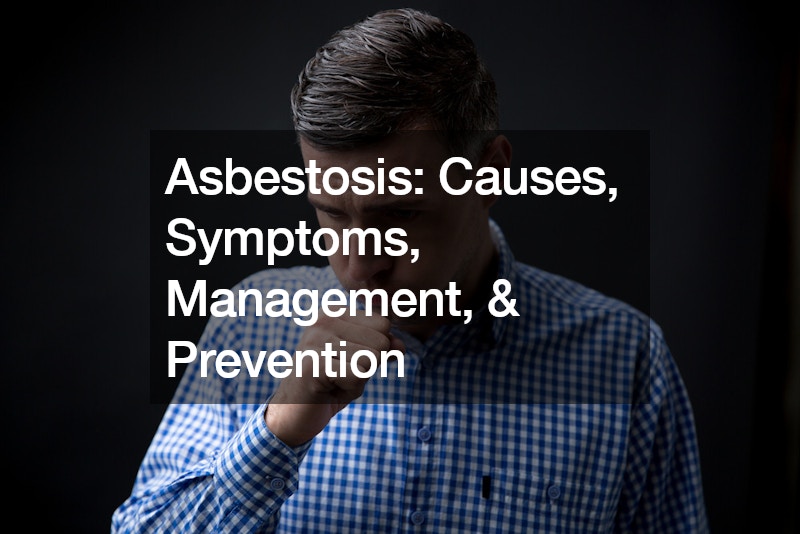
Asbestosis is a debilitating and progressive lung condition caused by long-term exposure to asbestos fibers. Asbestos, a naturally occurring mineral, was once commonly used in construction and manufacturing due to its resistance to heat and corrosion. However, the health risks associated with asbestos exposure have become increasingly apparent, and asbestosis is one of the most severe outcomes. This blog post will delve into the causes of asbestosis, its symptoms, and current management strategies.
What Causes Asbestosis?
Asbestosis is primarily caused by inhaling asbestos fibers. Asbestos is composed of microscopic fibers that, when airborne, can be easily inhaled into the lungs.
These fibers can cause significant harm as they become embedded in lung tissue, leading to inflammation and scarring over time.
The severity of asbestosis correlates with the cumulative dose of asbestos exposure. Long-term exposure to high levels of asbestos is particularly dangerous, but even lower levels of exposure can pose risks, especially if the exposure occurs over many years.
Fibers with a diameter of less than 3 micrometers are especially hazardous because they can penetrate the lung’s cell membranes and cause more damage compared to larger fibers, which are typically engulfed and removed by alveolar macrophages. When these small fibers remain in the lungs, they trigger inflammatory responses that lead to fibrosis, or scarring of lung tissue.
Symptoms of Asbestosis
The symptoms of asbestosis usually develop slowly and may not appear until 20 years or more after initial exposure. However, some individuals with high levels of exposure may experience symptoms sooner. The primary symptoms of asbestosis include:
- Exertional Dyspnea: Shortness of breath during physical activity is the most common symptom. As the disease progresses, this shortness of breath can become more severe and occur even at rest.
- Chronic Dry Cough: A persistent dry cough is another frequent symptom. In advanced stages, this cough may become more troublesome.
- Chest Discomfort: Some patients experience discomfort in the chest area, which may be noticeable during breathing or coughing.
- Bibasilar Crackles: On examination, doctors may detect crackling sounds at the base of the lungs, especially upon inhalation.
- Finger Clubbing: In advanced cases, about 30% to 40% of patients may show finger clubbing, where the tips of the fingers become rounded and swollen.
- Reduced Chest Expansion: There may be a noticeable reduction in chest expansion, which can be observed during a physical examination.
Diagnosing Asbestosis
Diagnosing asbestosis involves a combination of medical history, physical examination, and diagnostic tests. Key components of the diagnostic process include:
- Exposure History: A detailed history of asbestos exposure is crucial. This includes information about the duration, intensity, and type of asbestos exposure.
- Clinical Symptoms: Symptoms such as exertional dyspnea and bibasal crackles provide important clues for diagnosis.
- Imaging Studies: Chest X-rays or CT scans can reveal characteristic patterns of pulmonary fibrosis, such as diffuse interstitial lung disease and pleural plaques.
- Pulmonary Function Tests: These tests measure lung capacity and function, often showing a restrictive pattern of lung disease in asbestosis.
It is important to differentiate asbestosis from other fibrotic lung diseases that have similar symptoms but different causes.
Managing Asbestosis
Currently, there is no cure for asbestosis, but several strategies can help manage the disease and alleviate symptoms. These include:
Medical Management
While there is no specific medication for asbestosis, treatment focuses on managing symptoms and preventing complications. This can include antibiotics for respiratory infections and medications for symptom relief.
Vaccinations
To prevent additional respiratory infections, patients should receive vaccinations for influenza and pneumococcal pneumonia. These vaccinations help protect against illnesses that can exacerbate asbestosis.
Oxygen Therapy
For patients who develop hypoxia (low blood oxygen levels), supplemental oxygen may be necessary to help with breathing and improve overall quality of life.
Palliative Care
In advanced stages of asbestosis, palliative care may be required to manage distressing symptoms and improve comfort. This may involve a multidisciplinary team to address physical, emotional, and psychological needs.
Complications of Asbestosis
Asbestosis can lead to several serious complications. These include:
- Pulmonary Hypertension: Increased blood pressure in the lungs’ blood vessels can occur, which may lead to right heart failure (cor pulmonale).
- Cor Pulmonale: This condition, also known as right heart failure, results from the strain placed on the heart by lung disease.
- Progressive Respiratory Insufficiency: Over time, asbestosis can lead to a progressive decline in lung function, making it increasingly difficult to breathe.
- Lung Cancer: Asbestosis is a significant risk factor for developing lung cancer, particularly in individuals with a history of heavy asbestos exposure and smoking.
Prevention of Asbestosis
Preventing asbestosis involves minimizing or eliminating exposure to asbestos fibers. Here are several effective strategies for preventing asbestosis:
Avoid Asbestos Exposure
The most effective way to prevent asbestosis is to avoid exposure to asbestos. If you work in an industry where asbestos is present, use protective equipment such as masks and respirators designed to filter out asbestos fibers.
Regulate and Monitor Asbestos Use
Workplaces should adhere to strict regulations regarding asbestos handling and removal. Regular monitoring and maintenance of asbestos-containing materials are essential to prevent fiber release.
Safe Removal Practices
If asbestos removal is necessary, it should be performed by certified professionals. They will follow proper safety procedures to manage and dispose of asbestos waste.
Education and Training
Ensure that employees and contractors are educated about the risks of asbestos exposure and trained in safe handling practices.
Regular Health Check-ups
Individuals with a history of asbestos exposure should undergo regular medical check-ups to monitor lung health and catch any potential issues early.
In Summary
Asbestosis is a severe and chronic lung disease caused by inhaling asbestos fibers. Understanding its causes, recognizing the symptoms, and effectively managing the condition are crucial for improving patient outcomes and quality of life. While there is no cure for asbestosis, early diagnosis and appropriate management can help control symptoms and reduce the risk of complications.
If you or someone you know has a history of asbestos exposure and is experiencing symptoms, it is essential to seek medical advice for proper evaluation and management. Stay informed and proactive to better manage the challenges of asbestosis and work towards maintaining good lung health.
.




